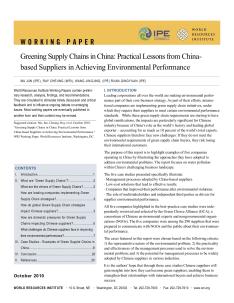Greening Supply Chains in China
Practical Lessons from China-based Suppliers in Achieving Environmental Performance

Synopsis
This working paper highlights examples of five companies operating in China and illustrates the approaches they have adopted to address environmental problems. The paper focuses on water pollution within China’s challenging business landscape.
Executive Summary
Leading corporations all over the world are making environmental performance part of their core business strategy. As part of their efforts, international companies are implementing green supply chain initiatives, under which they require their suppliers to meet certain environmental performance standards. While these green supply chain requirements are starting to have global ramifications, the impacts are particularly significant for Chinese industry because of China’s role as the world’s factory and leading global exporter – accounting for as much as 10 percent of the world’s total exports. Chinese suppliers therefore face new challenges: If they do not meet the environmental requirements of green supply chain buyers, they risk losing their international customers.
The purpose of this report is to highlight examples of five companies operating in China by illustrating the approaches they have adopted to address environmental problems. The report focuses on water pollution within China’s challenging business landscape.
The five case studies presented specifically illustrate:
- Management processes adopted by China-based suppliers.
- Low-cost solutions that lead to effective results.
- Companies that improved their performance after environmental violations.
- The role of multistakeholders and independent third parties as drivers for supplier environmental performance.
All five companies highlighted in the best-practice case studies were independently reviewed and selected by the Green Choice Alliance (GCA), a consortium of Chinese environmental experts and nongovernmental organizations (NGOs). The five companies were among the 290 suppliers that were prepared to communicate with NGOs and the public about their environmental performance.
The cases featured in this report were chosen based on the following criteria:
1) the representative nature of the environmental problem; 2) the practicality and effectiveness of the management processes used to solve the environmental problem; and 3) the potential for management processes to be widely adopted by Chinese suppliers in various industries.
It is the authors’ hope that through these case studies Chinese suppliers will gain insights into how they can become green suppliers, enabling them to strengthen their relationships with international buyers and achieve business success.